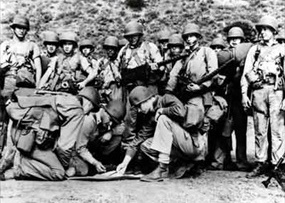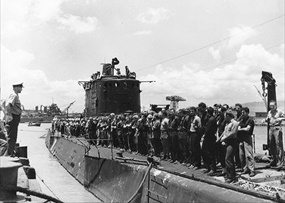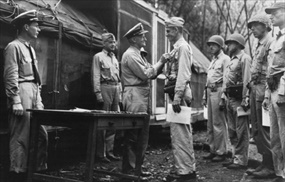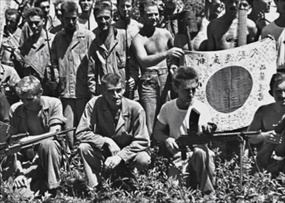2ND MARINE RAIDER BATTALION ACTIVATED
Washington, D.C. • February 16, 1942
In the wake of the December 7, 1941, Japanese attack on U.S. naval and army bases at Pearl Harbor, Hawaii, President Franklin D. Roosevelt settled on the U.S. Marine Corps as the home for a new commando-type force in the mold of British special operations forces to take the fight to the enemy. Nudged by U.S. Pacific Fleet commander Adm. Chester Nimitz, the commandant of the Marine Corps created 2 “raider” battalions, the 2nd Raider Battalion, activated on this date in February 1942 under the command of Lt. Col. Evans F. Carlson, whose creation he had influenced, and the 1st Raider Battalion, activated 3 days later under Lt. Col. Merritt A. Edson. Both Raider battalions saw action against the Japanese at about the same time, and each battalion, consisting of handpicked volunteers, earned a lasting place in Marine Corps history and mythology.
Of the 2 Raider battalions, Carlson’s 2nd Raider Battalion deviated more from the orthodox Marine Corps doctrine in training, organization, and discipline. During 2 Marine Corps duty tours in China, Carlson observed the guerrilla tactics and strategy of Mao Tse-tung’s Communist Chinese irregulars fighting the Japanese behind enemy lines, incorporating much of what he’d seen there into rigorous training, organizing, and motivating his men. For example, the 46‑year-old Marine eschewed strict respect for rank and the privilege it conferred on officers and embraced as his battalion’s battle cry the Chinese phrase “Gung-ho!,” meaning “work together,” egalitarian qualities that were foundational to 2nd Raider training.
Carlson’s elite force of Marine raiders thrilled Americans when they launched the first American offensive ground combat operation of World War II. Delivered by 2 submarines, their August 17–18, 1942, hit-and-run, touch-and-go raid on a Japanese seaplane base on tiny Makin Island (aka Makin Atoll or Butaritari Atoll) in the Gilbert Islands wiped out over half the enemy garrison and destroyed 2 flying boats bringing in reinforcements.
Carlson’s leadership in the Makin Raid earned him a second Navy Cross. (His first he earned in Nicaragua in 1930.) His third Navy Cross came for leading the “Long Patrol” (aka Carlson’s patrol) on Guadalcanal from November 4 to December 4, 1942. Using their trademark guerrilla tactics, a force of 220 Raiders infiltrated Japanese lines, disrupted enemy supply lines, inflicted a string of defeats on enemy forces mostly in small unit engagements during which nearly 500 Japanese were killed at a cost of 16 Raiders dead and 18 wounded, captured or destroyed large amounts of equipment, and gathered invaluable intelligence on Japanese operations on the island. When the attritional, 6‑month struggle for Guadalcanal was over (August 1942 to February 1943), America could claim its first major ground victory against the Japanese bushido juggernaut that for 3 years had ravaged Southeast Asia and the Pacific and in particular had threatened the supply routes between America and its ally, Australia.
Despite achieving their tactical objectives on Guadalcanal, the Raiders suffered terribly in the steaming jungle from the effects of malaria, jaundice, worms, diarrhea, ringworm, jungle rot, and malnutrition. Declared unfit for combat duty for months on end, Carlson’s men were injected into the Bougainville Campaign (November 1943 to August 1945). But by then Lt. Col. Carlson had been relieved of command and invalided to the U.S. His battalion was reorganized along more orthodox Marine lines. Once restored to health, Carlson saw fighting at Tarawa (late November 1943) as an observer and Saipan (June–July 1944), where he was wounded. Physical disability forced his retirement, at which time he received the rank of brigadier general. He died at age 51 on May 27, 1945.
The Elite of the Elite: Evans Carlson’s Raiders, 1942–1944
 |  |
Left: Shown here training near San Diego, California, for their Makin Island raid are 2nd Marine Raider Battalion commander Lt. Col. Evans Carlson, Major James Roosevelt (son of the U.S. President), and some of their men. The main objectives of Carlson’s Raiders were to gain intelligence, destroy installations, and divert Japanese reinforcements from the ongoing Allied battle on the islands of Guadalcanal and Tulagi in the Solomon Islands chain (August 7, 1942, to February 9, 1943). The diversionary Makin Island raid, when it was carried out on August 17–18, 1942, was touch and go. Two companies of Raiders wiped out just over half the Japanese garrison, destroyed radio stations, a fuel dump and other supplies, but gained little actionable intelligence. Marine casualties were 19 killed, 17 wounded, and 12 missing in action. Of the latter, 9 were inadvertently left behind or returned to the island during the nighttime withdrawal. They became captives, removed to Japanese-occupied Kwajalein Atoll in the Marshall Islands, and beheaded. Nonetheless, Carlson’s Raiders made welcome media headlines in a country surfeited with bad news (e.g., the loss of Wake Island, Guam, the Philippines) and led to the 1943 Hollywood war film Gung Ho!, starring Randolph Scott and Robert Mitchum, glamorizing their perilous exploits.
![]()
Right: USS Argonaut, a troop transport submarine, docked at Pearl Harbor after her return from the Makin Island raid, August 26, 1942. Carlson’s commandos and members of the submarine’s crew are on deck, as bands played and cheering people lined the piers. A battalion of Marines in dress blues stood stiffly at ready along with Admirals Chester W. Nimitz, commander in chief of the U.S. Pacific Fleet (standing left in photo), and Raymond Spruance, then Nimitz’s chief of staff. Reporters and cameramen recorded the heroes’ welcome. Nimitz and Carlson saluted each other on board the sub, Nimitz congratulating Carlson, saying “Makin has made you and your Raiders famous.”
 |  |
Left: Visiting Guadalcanal on September 30, 1942, Adm. Nimitz took time to decorate Carlson with the Navy Cross, the Marine Corps’ second-highest military decoration for extraordinary heroism in combat. In the right of the photo, second person in, is Col. Merritt A. Edson, commanding officer of 5th Marines Regiment and former commander of the 1st Marine Raider Battalion. Edson’s Raiders achieved fame in the Battle of Edson’s Ridge, aka Battle of the Bloody Ridge (September 12–14, 1942), when they beat back a desperate Japanese attempt to recapture Guadalcanal’s Henderson Field. Marine defenders suffered 80 killed to the Japanese 700–850 killed. The massive defeat at Edson’s Ridge contributed not only to Japan’s defeat in the Guadalcanal Campaign (August 7, 1942, to February 9, 1943) but ultimately to Japan’s defeat throughout the South Pacific.
![]()
Right: This photograph shows Carlson, kneeling front row center, probably during or after completing the Long Patrol (November–December 1942), part of the Guadalcanal Campaign. The Long Patrol was extremely successful from a tactical viewpoint (488 enemy killed) but came at excessive cost to the Raiders’ health and manpower strength. Two companies totaling 266 officers and men at the start of the patrol lost four-fifths of their numbers due to inadequate rations and tropical diseases when the patrol ended. Carlson’s Raiders, like the other 3 Raider battalions, were collectively disbanded in January 1944, most men transferring to the 4th Marine Division. A total of 8,078 servicemen, among them 7,710 Marines and 368 sailors, served in Raider units during the war.
Gung Ho!: 1943 Classic Wartime Movie Recounting Evans Carlson’s 2nd Raider Battalion Raid on Makin Island
![]()

 History buffs, there is good news! The Daily Chronicles of World War II is now available as an ebook for $4.99 on Amazon.com. Containing a year’s worth of dated entries from this website, the ebook brings the story of this tumultuous era to life in a compelling, authoritative, and succinct manner. Featuring inventive navigation aids, the ebook enables readers to instantly move forward or backward by month and date to different dated entries. Simple and elegant! Click
History buffs, there is good news! The Daily Chronicles of World War II is now available as an ebook for $4.99 on Amazon.com. Containing a year’s worth of dated entries from this website, the ebook brings the story of this tumultuous era to life in a compelling, authoritative, and succinct manner. Featuring inventive navigation aids, the ebook enables readers to instantly move forward or backward by month and date to different dated entries. Simple and elegant! Click 











